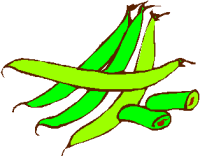
Weekly Gems from Ronda Gates.
 |
Weekly Message
Weekly Gems from Ronda Gates. |
|
"Beans, beans, the magic fruit--the more you eat, the more you toot." Source unknown. Despite the fact Scientist's can agree on a definition of fiber, exactly how much we need in our diet or what it does a growing mountain of evidence shows that fibrous materials in foods are beneficial.  Fiber is the carbohydrate in some foods which cannot be digested. Obviously if something can't be digested, it won't supply calories. Fiber also speeds up the digestive process. A high fiber meal is digested and processed in 12-14 hrs. (You've learned this if your summer diet includes corn on the cob.) A low fiber high fat meal takes 48 hrs. to move through the colon. The higher speed meals usually contain cellulose and hemicellulose, the insoluble fibers that provide bulk. They come in whole grains and cereals and fresh vegetables. The soluble fibers in fruits and beans--pectin and guar have a profound effect on blood glucose and the insulin response. They tie up sugar molecules so they are released into the blood stream very slowly. Refining these fibrous whole foods by cooking, grinding pureeing and juicing them takes the fiber benefits away. The exception is beans. Scientist believe the high protein content of the beans retains the fiber benefits. There's one downside of moving from a low fiber to a high fiber diet quickly. As these foods move rapidly through the intestines, some of it gets trapped in the miles of folds. Instead of being eliminated, the fiber breaks down slowly and gives you "gas" or a bloated feeling. You can eliminate the potential for a high fiber meal (like Mexican food) with a SAFE product called BEANO. A few drops on the first bite of a high fiber meal = NO BLOATING. Since even I have trouble figuring out how much fiber there is in food I prefer to use general guidelines for increasing dietary fiber. Here they are:
P. S. If you want to know more, my web site, under Smart Eating button, has a list of high fiber foods from each of the high fiber food groups (dairy products and meat, fowl and fish don't contain fiber). You will also find a changing daily, low fat, quick-to-fix, often high fiber recipe! |
| Weekly Messages | Lifestyles |
|
|
1378 Casada Ct, Leisure World Mesa, AZ 85206 Phone: 480-242-4812 |
| Web Site Design by JDL Design | |